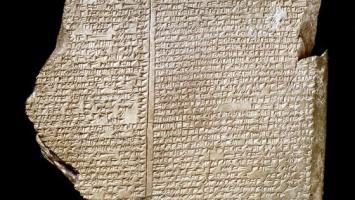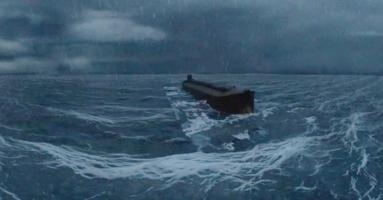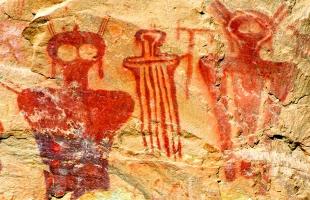The Universal Deluge

In the six hundredth year of Noah's life, in the second month, on the seventeenth day of the month, on that day all the springs of the vast waters of the abyss broke and the windows of the heavens were opened.
And it rained heavily on the earth for forty days and forty nights.
(Genesis 7:11 - 7:12)
And the waters overwhelmed the earth so greatly that all the high mountains that were under the heavens were covered. The waters overwhelmed them by fifteen cubits, and the mountains were covered.
(Genesis 7:19 - 7:20)
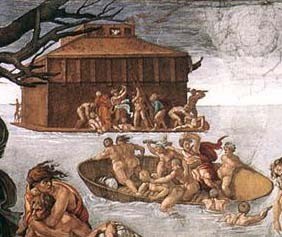
The Jerusalem Bible
Make yourself an ark of cypress wood; you will divide the ark into compartments and smear it inside and out with bitumen. Here's how you have to do it: the ark will be three hundred cubits in length, fifty in width and thirty in height. You will make a roof in the ark and a cubit above you will finish it; on one side you will put the door of the ark. You will do it in floors: lower, middle and upper.
Of what lives, of each flesh, you will bring two of each species into the ark, to keep them alive
Of the birds according to their kind, of the livestock according to their kind, and of all the reptiles of the earth according to their kind, two of each will come with you, to be kept alive.
Thus was exterminated every being that was on earth: with men, domestic animals, reptiles and birds of the sky; they were cut off from the earth and only Noah and whoever was with him in the ark remained.
After forty days, Noah opened the window he had made in the ark and brought out a crow to see if the waters had receded. It went out to and fro until the waters dried up on the earth.
Noah then brought out a dove, to see if the waters had receded from the ground; but the dove, finding no place to place the sole of the foot, returned to him in the ark, because there was still water all over the earth. He stretched out his hand, took it, and brought it back to him into the ark.
He waited another seven days and again he brought the dove out of the ark and the dove returned to him at dusk; behold, it had an olive branch in its beak. Noah understood that the waters had receded from the earth.
Introduction
In prehistoric times, the Black Sea was a large freshwater lake; in the period of the great glaciations the lake was surrounded by plains and plateaus. We have news of this lake in ancient Sumerian texts, this lake was fed by a river system from today's southern Russia and discharged its waters through an emissary that poured, along the Bosphorus, into the Aegean Sea.
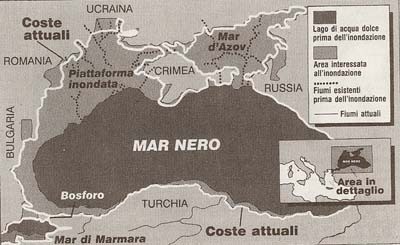
The transformation of this freshwater basin into a real sea took place about twelve thousand years ago. With the progressive increase in temperature due to the post-glacial period, the melting of the great glaciers, which in the previous millennia had formed the polar ice caps and which extended over much of the earth, the entire level of the oceans began to rise significantly. The sea began to outline the new profile of the emerged lands.
Subsequently, around the eighth millennium BC the populations of those areas realized that the lake was having difficulty in discharging its waters through the Bosphorus due to the pressure of the Aegean sea whose level tended to rise dramatically. Until, at a certain point, the salt water prevailed and managed to pass into the lake, rejecting the fresh one.
Gilgamesh or Noah
In 2350 BC in Mesopotamia King Sargon had an immense library of clay tablets built in his royal palace in Nineveh.
In 669 - King Ashurbanipal rebuilds the destroyed library begun by Sargon reconstitutes it by collecting all the cuneiform tablets that could be found in the territories, to give life to the first great library in history.
In the 20th century, archaeologists re-emerged the royal palace with its library from the desert sand. Among the 10,000 tablets recovered, archaeologists have recovered the Poem of Gilgamesh.
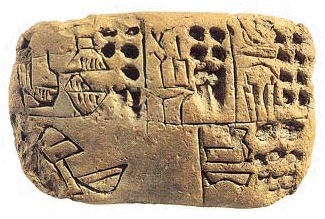
Myth and legend of Gilgamesh undoubtedly influenced (in 1290 BC) the author of the first biblical book of the Pentateuch: the genesis.
Recent studies have established the existence of this Gilgamesh. Professor Stephanie Dailey - a lecturer at the University of Oxford - has however advanced strong doubts about the existence of an epic poem centered on the hero we have referred to. According to Dailey, Gilgamesh was actually only a king, lord and master of the city of Uruk, in Mesopotamia, who lived around 4500 BC. C., a period too far away, to the catastrophe that struck the Black Sea and surrounding areas.
But the Gilgamesh to which the Oxford professor refers could in fact be a namesake of the hero of whom the Sumerian myths speak and who makes himself live precisely around 7500 or even earlier. In recent years, interesting studies have revealed the veracity of the existence of this population, whose appearance in the region around the Black Sea (formerly a lake in the antediluvian era) dates back to the mid-seventh millennium BC.
What have researches discovered ?
Sir Leonard Woolley (1880-1960) carried out an archaeological excavation campaign between 1928 and 1934 on the site on which the ancient city of Ur stood. As Woolley will ascertain in UR, the Deluge of the legend is one of the many so far ascertained catastrophic deluge-floods. The Mesopotamian plain is 5 times larger than the Po Valley (which is also subject to floods) and there are 2 rivers, the Tigris and the Euphrates, in many hanging points on the surrounding countryside that join together for about 2800 km (5 times the river Po).
With these conditions, the whole area is subject to flooding, the surrounding area is formed by sediment coverings that can be measured in the various eras.
Unfortunately in 612 BC the king of Babylon Napolassar and the king of the Medes Ciassare, put an end to the Assyrian empire; destroying everything.
During this campaign the excavation workers came across a layer of alluvial mud, this layer made Woolley suspicious as it was several meters higher than the surrounding level, which could mean that, below this layer of silt, there it could be a stratification of finds from an earlier period.
Two meters below, the sensational discovery awaited them of flint tools and pottery fragments subsequently identified as dating back to the Third Period of Ubaid, conventionally dated between 4500 and 4000 BC. The microscopic analysis of the muddy sediments excluded a marine origin and suggested a catastrophic flooding due to the overflow of the Euphrates River as a possible cause.
It is therefore inevitable to associate this discovery with the story of Noah and the Sumerian tales revealed in all their mysterious similarity to the biblical saga of the Flood thanks to the deciphering of the cuneiform script.
But excavations in the Iraqi region formerly occupied by Sumerian settlements did not cease and traces of a second Flood appeared before everyone's eyes.
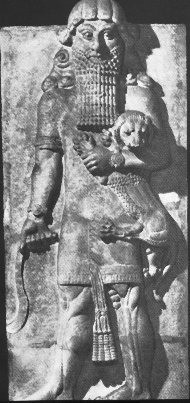
The archaeologist author of the discoveries was Stephen Langdon, who in 1929 published the report of the discovery of traces of a flood near the cities of Shuruppak (modern Fara) and Kish: the stratigraphic analysis allowed to place the event in the period historian called Proto-dynastic dated between 2900 and 2700 BC.
The dating decidedly more recent than the one attributed to the Woolley Flood, abundantly in historical period and consequently well documented with literary works, and the coincidence with the fact that Shuruppak is the city named in the Epic of Gilgamesh pushed in an overbearing way to consider "authentic" the Flood revealed by the Langdon excavations.
The dispute, of course, held the attention of public opinion and had wide prominence even in the newspapers of the time with authentic hunts for the latest scoop.
And recently ...
Recently, thanks to Robert Ballard's expedition and above all to his "Little Hercules, a remote-controlled robot-submarine, reeds mixed with mud and clay, corresponding to old beams of a hut of about 35 square meters, around which there are artifacts and tools in excellent condition. For scholars there is no doubt: it is a building dating back to the Neolithic.
To support the hypothesis of the gigantic flood, also the absence of oxygen in the waters of the Black Sea, below the surface. Which makes it particularly sterile, but which offers a convincing explanation of how the structures made of wood and other perishable material have managed to be preserved after thousands of years in excellent condition.
In 1993, a group of American geologists led by William F. Ryan and Walter C. Pittman of the Lamont-Doherty Eart Observatory at Columbia University in Palisades, N.Y., presented the results of their geological and oceanographic research on the origins of the Black Sea, it is believed that about 7,500 years ago the large area occupied today by the Black Sea was probably a fertile plain cultivated by agricultural populations from the Middle East. It housed, in its most depressed part, a small lake and its altitude was far below the level of the nearby Mediterranean Sea.
Several finds on the seabed of the Black Sea of fossilized freshwater shells discolored by sunlight; they would prove that they had been dry for a long time, confirming this thesis by hypothesizing exceptional meteoric events, the sudden overturning of the Mediterranean water in correspondence with the current Dardanelles Strait. Human settlements were thus overwhelmed and canceled.
Similar results were also obtained by the Russian Academy of Sciences which with an oceanographic vessel - through seismic surveys and underwater cores - redesigned the coasts of the ancient lake that existed before the flood. And it was found that the people who escaped and escaped the cataclysm spread agriculture in Europe and Mesopotamia. Among these people were the Sumerians who swept the region between the Tigris and the Euphrates. In the western part of Europe, on the other hand, the other peoples arrived and brought their agricultural techniques with them. Together with the techniques related to agriculture, however, these tribes who escaped the cataclysm preserved and handed down over the centuries the memory of the great fear, of the immense tragedy that, from generation to generation, took on the contours of the myth, that of the Universal Flood.
What people say in the world
The concept of wicked men being punished by the flood recurs in countless traditions. We meet Noah all over the globe, sometimes even with his name, from the Hawaiian Nu-u, to the Chinese Nuwah, to the Amazonian Noa.
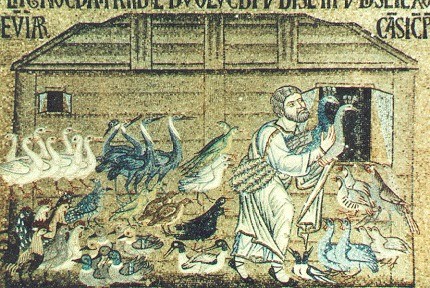
In Paraguay and Brazil it is also Tamanduare, in Mexico Tapi or Nala 'and becomes Pokawo for the American Delaware, Manibusho for the Canadian Indians, Zeukha for the Patagons, Yima in Persia, Dwifa in Celtic legends.
For the Greeks ... Deucalion and Pyrrha
Men misbehaved, angry Zeus punished them, they hated each other. Zeus unleashed a storm with great winds due to the behavior of humans.
Conscious men began to do rites and prayers, but the god did not listen to them. In Ftia Deucalione and Pirra, honest beings well liked by the gods, they saved themselves by taking refuge in an ark and rescued pairs of animals.
The flood lasted 9 days and 9 nights, when they realized that the rain had stopped the two looked out to see the world, but they saw only an immense expanse of water. The ark touched the ground and Eucalione and Pirra went down and realized they had landed on Mount Parnassus.
Hermes arrived and brought them a message that spoke of Zeus's decisions. They would have had the opportunity to be calm. The two decided that this blessing should fall on the entire human race and asked Hermes for advice. This told them to throw the bones of the great mother behind them. The two immediately did not understand, then they guessed the solution, took some stones and threw them behind them and they took on the appearance of men and women.
For Indians
Manu, son of the sun god, was bathing by the river. There was a small fish named Matsya in the palm of his hand. He felt sorry for him because he could be eaten by the greatest; he put it in an earthenware jar full of water. Then he grew up and dug a moat for it. Later it grew bigger and took it to the ocean. Matsya told Manu that a deluge would come in a few years. He suggested they build a ship to save himself and Matsya promised that he would go and rescue him. The day arrived and Matsya came to take Manu and took him to the top of a mountain.
For Africans
Kapinga had no wife. One day he met a woman and took her home. The woman did not want to eat, because her husband did not know her name. Kapinga turning met Kakulutu Kamunto who told him the name of his wife that is Tumba. Kapinga and Tumba went to the village of the woman's father. Arrived, they stayed for a long time. After a while Kapinga wanted to go home and the village chief (Tumba's father) told him to come back for his wife on a rainy day. Kapinga agreed and then returned home. After some time of drought, the husband went to his wife's village. When he arrived he found no one, but he saw some stones; he took one and sharpened his knife and then went home. When it began to rain Kapinga returned to the village of Tumba and meeting the inhabitants asked to have his wife back, but his father denied him permission because when he went to the village during the drought, sharpening his knife on that stone he had made a big wound to the village chief because he was that stone. Kapinga returned home without a wife.
For Tahiti
Tahiti was once submerged by the sea, only two people and the animals they rescued survived on the island; the disaster began with heavy rains and a raging storm that ended up engulfing the entire island. To save themselves together with the animals, the two human beings took refuge on the highest mountain PITO-HITI. Finally after 10 nights the rain stopped and the sea dropped, so life, thanks to the couple, returned to flourish on the island. Only a kind-hearted family was saved, building a spacious ark to shelter every animal species.
For Brazilians
The snake Kane-roti made the Rio Tocantins and Rio Araguaia. It rained for many days, the streams overflowed; the waters of the Tocantis reached those of Araguaia. For 2 days the world was submerged. The Apinaye fled the Sierra Negra. A married couple took three giant pumpkins and filled them with food, mostly grains; they closed them, tied them and clung, allowed themselves to be carried adrift. Suddenly it rained again, but the two got away with it. When the water went down, the couple looked for a place to settle and there they set about building a farm.
One day a surviving boy killed a bird and took it to his mother to cook.
The mother noticed that the bird had corn seeds in her stomach and asked her son where she had gotten it after hearing the news; people went in search of the place; found the farm, they stayed until autumn to collect food.










